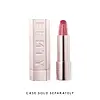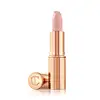Fenty Beauty Fenty Icon The Fill Semi-Matte Refillable Lipstick Versus Charlotte Tilbury Hot Lips Lipstick
What's inside
What's inside
 Key Ingredients
Key Ingredients

 Benefits
Benefits

 Concerns
Concerns

 Ingredients Side-by-side
Ingredients Side-by-side

Octyldodecanol
EmollientDiisostearyl Malate
EmollientDimethicone
EmollientPolyethylene
AbrasivePentaerythrityl Hydrogenated Rosinate
Aluminum Starch Octenylsuccinate
AbsorbentLauroyl Lysine
Skin ConditioningSilica
AbrasiveNylon-12
Trimethylsiloxysilicate
EmollientPolypropylsilsesquioxane
Hydrated Silica
AbrasiveSynthetic Wax
AbrasiveParfum
MaskingOctyldodecyl Neopentanoate
EmollientDisteardimonium Hectorite
StabilisingWater
Skin ConditioningSorbitan Oleate
EmulsifyingTribehenin
EmollientMica
Cosmetic ColorantCandelilla Cera
EmollientCaprylyl Glycol
EmollientAroma
Propylene Carbonate
SolventHydrolyzed Hyaluronic Acid
HumectantTocopherol
AntioxidantTocopheryl Acetate
AntioxidantTetrahexyldecyl Ascorbate
AntioxidantPentaerythrityl Tetra-Di-T-Butyl Hydroxyhydrocinnamate
AntioxidantCalcium Sodium Borosilicate
Calcium Aluminum Borosilicate
Synthetic Fluorphlogopite
Tin Oxide
AbrasiveBenzyl Benzoate
AntimicrobialLimonene
PerfumingIron Oxides
CI 15850
Cosmetic ColorantCI 77891
Cosmetic ColorantOctyldodecanol, Diisostearyl Malate, Dimethicone, Polyethylene, Pentaerythrityl Hydrogenated Rosinate, Aluminum Starch Octenylsuccinate, Lauroyl Lysine, Silica, Nylon-12, Trimethylsiloxysilicate, Polypropylsilsesquioxane, Hydrated Silica, Synthetic Wax, Parfum, Octyldodecyl Neopentanoate, Disteardimonium Hectorite, Water, Sorbitan Oleate, Tribehenin, Mica, Candelilla Cera, Caprylyl Glycol, Aroma, Propylene Carbonate, Hydrolyzed Hyaluronic Acid, Tocopherol, Tocopheryl Acetate, Tetrahexyldecyl Ascorbate, Pentaerythrityl Tetra-Di-T-Butyl Hydroxyhydrocinnamate, Calcium Sodium Borosilicate, Calcium Aluminum Borosilicate, Synthetic Fluorphlogopite, Tin Oxide, Benzyl Benzoate, Limonene, Iron Oxides, CI 15850, CI 77891
Octyldodecanol
EmollientPolybutene
Pentaerythrityl Tetraisostearate
EmollientEthylene/Propylene Copolymer
AbrasiveCaprylic/Capric Triglyceride
MaskingVp/Hexadecene Copolymer
Diisostearyl Malate
EmollientSilica
AbrasiveHydrogenated Styrene/Methylstyrene/Indene Copolymer
Mica
Cosmetic ColorantOzokerite
Emulsion StabilisingDicalcium Phosphate
AbrasiveStearalkonium Bentonite
Gel FormingPropylene Carbonate
SolventPentaerythrityl Tetra-Di-T-Butyl Hydroxyhydrocinnamate
AntioxidantCrambe Abyssinica Seed Oil
Skin ConditioningEthyl Vanillin
MaskingBixa Orellana Seed Extract
MaskingBHT
AntioxidantTin Oxide
AbrasiveCI 77891
Cosmetic ColorantIron Oxides
CI 15850
Cosmetic ColorantCI 19140
Cosmetic ColorantCI 15985
Cosmetic ColorantCI 77742
Cosmetic ColorantCI 77163
Cosmetic ColorantCI 73360
Cosmetic ColorantCI 45380
Cosmetic ColorantCI 45410
Cosmetic ColorantCI 42090
Cosmetic ColorantOctyldodecanol, Polybutene, Pentaerythrityl Tetraisostearate, Ethylene/Propylene Copolymer, Caprylic/Capric Triglyceride, Vp/Hexadecene Copolymer, Diisostearyl Malate, Silica, Hydrogenated Styrene/Methylstyrene/Indene Copolymer, Mica, Ozokerite, Dicalcium Phosphate, Stearalkonium Bentonite, Propylene Carbonate, Pentaerythrityl Tetra-Di-T-Butyl Hydroxyhydrocinnamate, Crambe Abyssinica Seed Oil, Ethyl Vanillin, Bixa Orellana Seed Extract, BHT, Tin Oxide, CI 77891, Iron Oxides, CI 15850, CI 19140, CI 15985, CI 77742, CI 77163, CI 73360, CI 45380, CI 45410, CI 42090
Ingredients Explained
These ingredients are found in both products.
Ingredients higher up in an ingredient list are typically present in a larger amount.
Ci 15850 is the pigment color red. It is an azo dye and created synthetically.
Azo dyes need to be thoroughly purified before use. This allows them to be more stable and longer-lasting.
This ingredient is common in foundations, lipsticks, and blushes. This color is described as brown/orangey red.
It has many secondary names such as Red 6 and Red 7. According to a manufacturer, Red 6 usually contains aluminum.
Learn more about CI 15850Ci 77891 is a white pigment from Titanium dioxide. It is naturally found in minerals such as rutile and ilmenite.
It's main function is to add a white color to cosmetics. It can also be mixed with other colors to create different shades.
Ci 77891 is commonly found in sunscreens due to its ability to block UV rays.
Learn more about CI 77891Diisostearyl Malate is an emollient and most often used in lip products. It comes from isostearyl alcohol, a fatty acid, and malic acid, an AHA.
As an emollient, Diisostearyl Malate helps create a thin film on your skin to trap moisture in. This helps keep your skin soft and smooth.
Mica is a naturally occurring mineral used to add shimmer and color in cosmetics. It can also help improve the texture of a product or give it an opaque, white/silver color.
Serecite is the name for very fine but ragged grains of mica.
This ingredient is often coated with metal oxides like titanium dioxide. Trace amounts of heavy metals may be found in mica, but these metals are not harmful in our personal products.
Mica has been used since prehistoric times throughout the world. Ancient Egyptian, Indian, Greek, Roman, Aztec, and Chinese civilizations have used mica.
Learn more about MicaOctyldodecanol is a fatty alcohol. It is primarily used to enhance the texture of products.
As an emulsifier, Octyldodecanol helps prevent the oils and waters from separating. It also prevents ingredients from creating foam when shaken.
Octyldodecanol is created by reducing fatty acid to an alcohol.
Due to its high molecular weight, it does not get absorbed into the skin.
Learn more about OctyldodecanolPentaerythrityl Tetra-Di-T-Butyl Hydroxyhydrocinnamate (long name, huh?) is a synthetic antioxidant.
It is used to help stabilize other antioxidants or prevent the color from changing in a product.
As an antioxidant, it helps fight free-radical molecules. Free-radical molecules are capable of damaging our cells and other genetic material. Thus, antioxidants may reduce the signs of aging.
This ingredient is oil-soluble.
Learn more about Pentaerythrityl Tetra-Di-T-Butyl HydroxyhydrocinnamateThis ingredient is a solvent. It helps dissolve active ingredients and alter the texture of products.
Propylene Carbonate is commonly used in makeup and with clay, such as montmorillonite or bentonite.
Studies show this ingredient to be safe for cosmetics. When it is undiluted, it can cause skin irritation. (It is always diluted in skincare and makeup). This ingredient is water-soluble.
Propylene Carbonate is created from propylene glycol and carbonic acid.
Learn more about Propylene CarbonateSilica, also known as silicon dioxide, is a naturally occurring mineral. It is used as a fine, spherical, and porous powder in cosmetics.
Though it has exfoliant properties, the function of silica varies depending on the product.
The unique structure of silica enhances the spreadability and adds smoothness, making it a great texture enhancer.
It is also used as an active carrier, emulsifier, and mattifier due to its ability to absorb excess oil.
In some products, tiny microneedles called spicules are made from silica or hydrolyzed sponge. When you rub them in, they lightly polish away dead skin layers and enhance the penetration of active ingredients.
Learn more about SilicaTin Oxide is an inorganic oxide used to add opacity and volume to a product. In nature, it is already found in mineral form. The main ore of tin is an opaque and shiny mineral called casseterite.
Tin Oxide helps remove translucency in a product, or make it more opaque. Besides adding opacity, tin oxide is used for bulking to add volume.
This ingredient is a combination of red, black, and yellow iron oxide pigments. This combination of colors is usually found in foundation, because it results in a "skin" color.